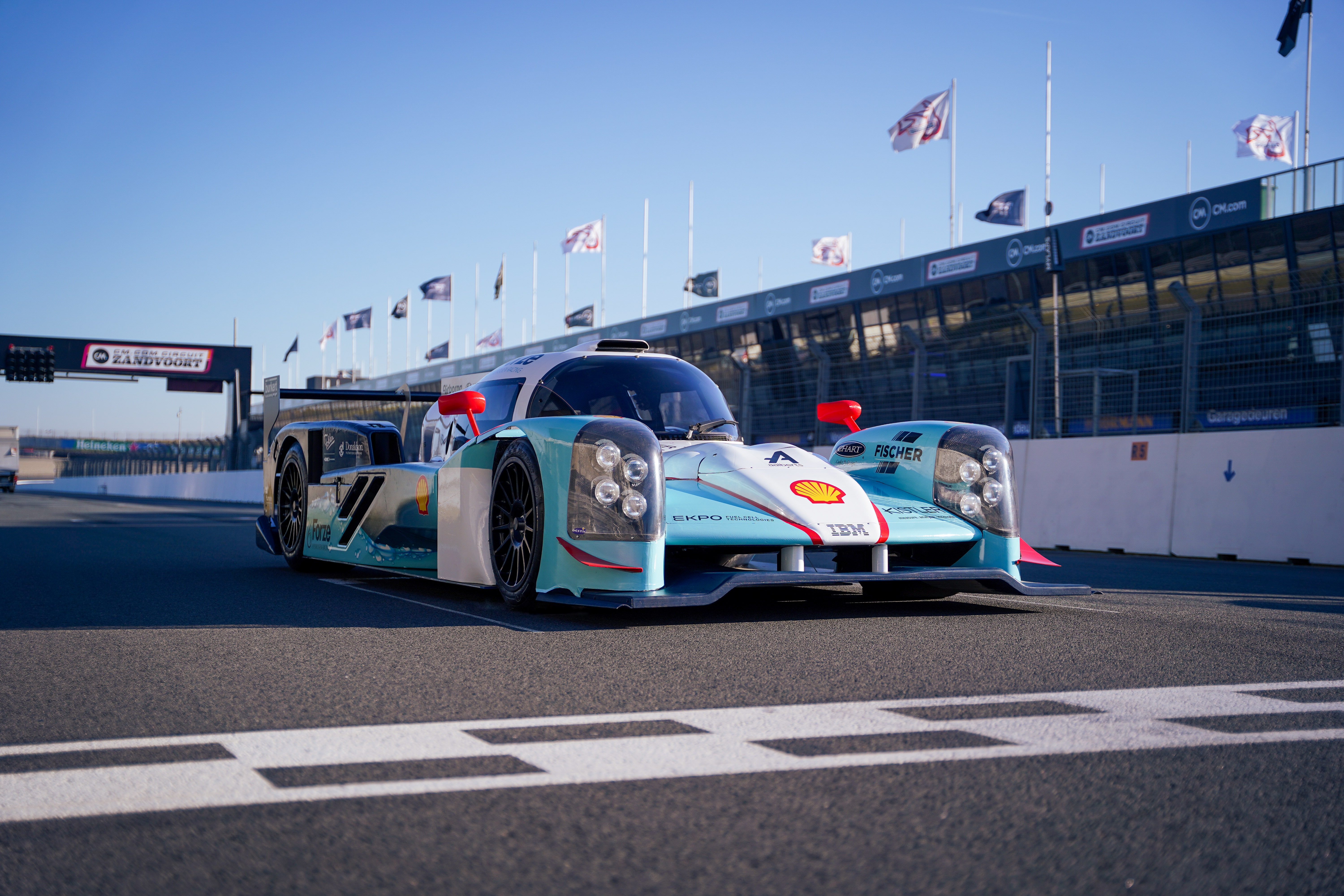Hydrogen supercar built by dutch student team

Hydrogen-fuelled cars do exist, but can they compete with high-performance cars, such as the supercars running in official races ? Yes, they can, answers Dutch team Forze Hydrogen Racing. The proof is their spectacular Forze IX, designed to become the fastest hydrogen car in the world.
With its 5 m by 2 m dimensions, aggressive features, painted sky blue and white, the Forze IX has the looks of a supercar. Its performance dashing from 0 to 100 kmph in less than 3 seconds, reaching a ma imum speed of 300 kmph - is also that of a supercar. However, its engine is unique : a dual proton exchange membrane fuel cell, powered by four hydrogen tanks compressed to 700 bars, producing the electricity to move the four drive wheels.
Forze Hydrogen Racing has been preparing this car in view of participating in the Supercar Challenge, a series run on circuits in the Netherlands (Zandvoort, Assen), in Belgium (Spa, Francorchamps) and Austria (Red Bull Ring). “ We want to compete in GT category, the fastest of all, alongside Porsche, Ferrari, Bentley, BMW… ” explains team leader Abel Van Beest. To face them as equals but emitting only a little water vapour in the atmosphere.
Created in 2007 within Delft Technical University, Forze Hydrogen Racing developed, within a few months, a first model from scratch. Forze I, a 266-kg kart that accelerated from 0 to 90 kmph in less than 5.5 seconds was then considered as the first hydrogen race car in the world. It took ten more years of passionate work for another Forze – the VII – to become the first one to enter a professional competition (a Supercar Challenge race).
The journey is all the more remarkable considering that it is the work of a continuous succession of students. The first team, back in 2007, involved about 40 part-time contributors. Presently, there are around sixty team members, half of them enjoying a gap year to be fully dedicated to the project (if 80 hours a week is simply considered “ full-time ”). The team is renewed every year, which means an enormous challenge as far as knowledge transfer is concerned (shortly after his interview, Van Beest has actually handed over the lead to his successor). Luckily, more than one of the “ oldies ” stay active, adds Van Beest : “ a hundred or so alumni continue to help us ! ”
Forze Hydrogen Racing has progressively distanced itself from TU Delft and finally set up a non-profit association in 2020. 90% of its staff are still from the Dutch university, but it has also opened up to outside talent.
Three years have been dedicated to the Forze IX, which resulted in exceptional performance.
“ Fuel cells are very good in delivering constant power ”, explains the team leader. “ But to stand up to petrol-fuelled cars, we had to boost power. We have designed an additional battery system which added an extra 360 kW, which is altogether 600 kW, twice that of Forze VIII ! ”
This increase entailed providing much more hydrogen to the fuel cell as well as other adaptations requiring extra space. “ So, we had to completely reconsider a number of components – recirculation pump, ejector system, gear box… to make them more compact. ”
The fuel cell is supplied by a German company EKPO, but all the surrounding systems have been designed by Forze Hydrogen Racing, says proud Van Beest. “ We have developed solid know-how in efficiently conveying hydrogen and oxygen to the cell. And, more generally, in integrating all these technologies in a race car. ”
Forze Hydrogen Racing would not have succeeded without convincing an impressive list of small and large partners (currently more than a hundred). “ Some give us money ; many more provide technological support ”. This is the case with LEMO, supplying robust F Series connectors. Some partners help us in other fields, such as marketing or communication. ”
Forze IX was presented with much pomp and circumstance in February 2022. Since then, the team has been working on validating the design and, most of all, producing multiple components.
“ We create and produce as much as possible in-house. This is one of the challenges of the project, but also a substantial part of the students’ training. It involves a lot of testing and repeat visits to the drawing board. ”
The first road tests have been run this year. In particular, those of the drivetrain and the hydrogen system. Participating in the Supercar Challenge races is planned for 2024. A first one in April, then, depending on the driving characteristics and reliability of the car, some others. Ideally, ALL the others. On the longer term, the team plans to pass endurance tests and is dreaming about the iconic 24 Hours of Le Mans.
However, the races are but a minor part of the mission, concludes Abel Van Beest. “ Forze Hydrogen Racing has chosen motorsport, because it is extremely demanding in terms of engineering. And because it is very “ sexy ” – useful to attract students, partners, the media, the public… But we are using this application to tell a story on a larger scale : hydrogen will play a crucial role in the energy transition that our planet needs. It is important to tell this story and to train young engineers who will make it a reality. ”
The 24 Hours of Le Mans run with a hydrogen engine ?
Forze Hydrogen Racing wants to make that dream a reality.



